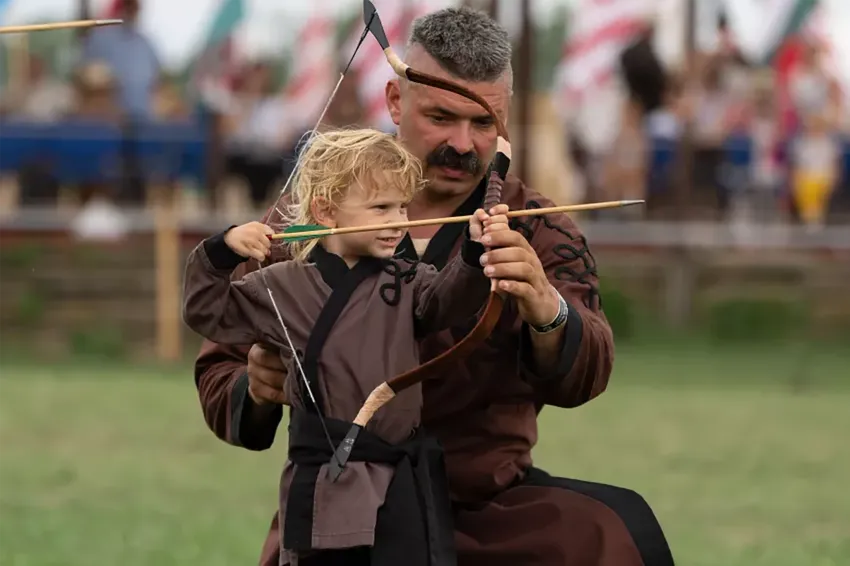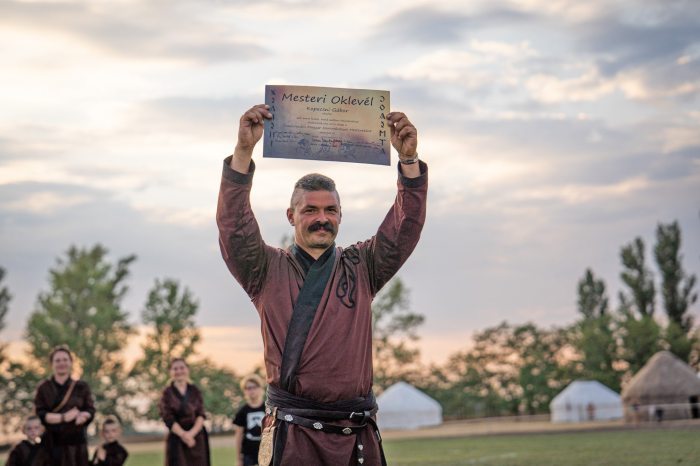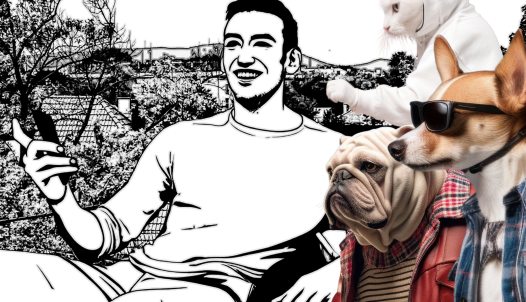"Other peoples' cultures will always be foreign!" – Gábor Kopecsni collects and teaches Hungarian combat techniques
Hungarians are inherently a warrior nation; so there must necessarily be martial art traditions specific to them. Gábor Kopecsni, the founder of the Dalia School of Upper Hungary, has devoted his life to researching these techniques. The expert, who not only teaches traditional Hungarian martial arts, but also constantly collects, researches, and systematizes them, is convinced that the culture of other peoples, no matter how sensational, will always remain alien to a Hungarian. Krisztián Pomichal talked with him about paths, wrong ways, martial arts, and tradition.

The first question is obvious: when did you first get involved in martial arts?
The first steps of my journey were nothing special. Like most people my age, karate was the " great encounter " for me. I started karate in my hometown of Dunaszerdahely, Slovakia, where I was introduced to aikido. Later I learned that there was a martial arts college in Budapest, so after graduation I moved to the capital and studied at The Dharma Gate Buddhist College, specializing in budo-aikido.
Not a typical higher education career...
Well, no, not really! (laughs) The college was a very interesting place, with lots of excellent people. But I was a little disturbed from the start by how much some people fell in love with a foreign culture. Japanese culture is extremely rich and wonderful, but not ours. It never will be, even if we fancy ourselves more Japanese than the Japanese.
Did you have a big realisation or did this idea gradually grow in you?
ne specific moment. I rarely went home, but one weekend when I did, my friends and I cycled to a small town near Dunaszerdahely, where there was a mounted archery show.
As I stood there with my friends, I was almost slapped in the face by the feeling that the thousand-year-old Hungarian combat traditions were still alive!
They are revived, they are available, and you can learn them either well or badly. Until then, I was not particularly interested in the Hungarian tradition, I was comfortable in the "Japanese" environment, but then something changed in me. I found out the name of the gentleman conducting the show, it was Imre Rőth. A few days later I approached him and asked him to teach me. I started with archery and horse riding, and later I took up the whip. I went to aikido training during the weekdays, and on weekends I immersed myself in traditional Hungarian martial techniques.
How does this turn into the founding of a school, dozens of textbooks, and a life dedicated to preserving tradition?
These were just the first kilometres of the journey. I never wanted to start a school, but I started to train more and more, and I started to realize how much there is around me, and how incredibly rich our culture is. It bothered me more and more when Hungarians pretended to be Japanese. In martial arts, the idolization of Japanese culture was given an extra layer: many times Hungarians watched Japanese aikido with such awe that it was almost comical. Around 2005, we went to Tahitótfalu for a solstice celebration, and right at that time, there was a Baranta training camp there. (Baranta is a continuously developing martial art, which has been created by collecting all the movements from Hungarian body culture, fighting, and battling techniques that had been applied during our history - translator's note). We met the school's founder, Ferenc Vukics, and it turned out that they were training in Budapest, so I didn't have to go far. That autumn I started learning Baranta and gradually abandoned Aikido, and the Hungarian martial tradition slowly took over my life.
I made a quick count, in the last almost two decades you have written fifteen books on the old Hungarian martial arts. Even if someone trains a lot, it does not necessarily mean that they will start writing a series of professional books.
Strangely enough, it is precisely my lack of knowledge that I owe these books to. It made me realize how little I know about Hungarian history, ethnography, folk culture, and Hungarian traditions.
I started reading books on History and Ethnography, to fill in the gaps I had missed. You can only do something well if you know the medium well, in this case, the whole of the tradition behind it.
It's obviously a lot to take in, but to this day I read a lot, and I try to improve myself. But I wouldn't call what we do old Hungarian martial arts...
What would you call it? Fighting sport?
No, not really! (laughs) Martial arts are primarily about the individuality and the spirituality of a person while fighting sports is about physical performance and competition. There is no sharp boundary, it is impossible to define and separate the two concepts, these are more my own impressions. In both of them, the personality of the person is inevitably present, take saber fencing for example. The more extroverted, more boisterous students are always more aggressive, while the more introverted, more reserved fencers prefer to play the counter.
Many people do not understand the term martial arts. When these techniques were used in real life, in battle, man against man, nobody called what they did martial arts. It is probably best to refer to them as schools - in the East and in our country. There were so-called 'military schools' in Hungary's border forts. The first appearance of martial arts as a concept dates from the mid-19th century's Japanese imperial revival, the Meiji Restoration. The aim was to abolish traditional schools, to break the power of the samurai, and to pacify the development of martial arts schools. The result of this process is that today karate or judo are Olympic sports.
But I'll tell you something else! If we are talking about the dances of the Hungarian people, is it worth talking about "folk dance" before the first ethnographic recording of these dances or before the first appearance of Western influences? I don't think so. At most, we should talk about the dances of the folk. Because nobody called it folk dance at that time, because it was "the" dance. In the same way, it makes no sense to talk about old Hungarian martial arts techniques, because they were once "the" fighting techniques.
I like the term folk combat body culture, it's a bit of a mouthful, but perhaps it captures reality most accurately.
We practice in a systematic way what they used to practice, that's what we call martial arts today. We don't learn the techniques to go into battle.
In this respect, does it even make sense to talk about Hungarian martial arts philosophy? And the mentality you mentioned before?
I think it is, in fact it is essential. I believe in the unity of body, soul, and spirit, in the power of individuality. Many martial arts schools, both in the East and the West, tend to see their own way as the only true way. If you do this or that technique differently, if you go left instead of right, you are not a member of the community. This is partly an understandable self-defense mechanism, but it is also extremely counterproductive. Since its foundation, the Dalia School of Upper Hungary has placed a strong emphasis on individual freedom, on personal identity. If you believe in our values and act on them, go to training, practice hard, and strive to be a better person, you are on the path of Dalia School.
Here we are in a yurt, surrounded by dozens of books, a whole series, all with your name on them. So, how did you start collecting?
By car. (laughs) All joking aside, I really set off for the Carpathian Basin. Part of the Baranta training was to do your own collecting. I took the task quite seriously! At home, next door lived a man from Upper Hungary, Bandi Raisz. I knew that he used to do folk dancing, even the one that is a men's dance and they dance it with a stick, and I stopped by his house to ask him to tell me about it. It turned out that as a child in the hills of Gömör, he used to practise stick wrestling. He sent me on to his brother-in-law, a shepherd man living in Ajnácskő, Józsi Molnár, who showed me more techniques and drills.
The feeling gave me goosebumps that it was still possible to meet people like that in the twenties, meaning that this knowledge was still alive.
It started like this, from here on I was basically handed down from hand to hand by the "old men".Then I had an idea to collect traditional fighting techniques from a specific region, be it wrestling, wrestling with a stick, or even the related folk games. Since then, several regions of Historical Hungary, eg.: Csallóköz, Mátyusföld, Zoboralja, Upper Ipoly-mente, Gömör, within Gömör the Barkóság, Abaúj-Torna, Upper-Bodrogköz, the Ung-vidék in the Felvidék and the Transylvanian Barcaság have got their own volume in the Small Library series of the Dalia School of Upper Hungary.
Why is it called the Dalia School of Upper Hungary and not of the Highlands?
The reason is very simple, we were afraid that the "highland" Dalia School would not be officially registered by the Slovak authorities. The term "Felvidék" (Highlands) came into the public consciousness after the Trianon dictate, and in the ethnographic world, the region was previously referred to as Felföld (Upper-land), even if it was not exactly the same area. But the meaning of the word is practically the same.
What’s the connection between your Dalia School and Baranta?
I myself started by studying for many years and I owe a lot to Baranta. I started to go and visit the "big names" in the 2010s.
I visited Lajos Kassai in the Valley, I learned stick techniques from Zsolt Pucskó, I got original recordings of the stick dance from folk dance researcher Laci Felföldi, and I visited old old people in Transylvania and Upper Hungary.
I've been doing it for over fifteen years, I've met hundreds of wonderful people, and collecting has been the defining experience and meaning of my life. The point is that our "baranta" in Upper Hungary has gradually become independent, and I have tried to improve it. Finally, in 2018, we got to the point of going our own way, so I founded the Dalia School of Upper Hungary, based on years of practical experience and research results, which has a unique teaching and examination system and is now working officially.
You've travelled the Carpathian Basin, meeting hundreds of members of the so-called "grand old" generation, perhaps the last representatives of a bygone world. What have you experienced, is there a Hungarian character? And if so, what is it like?
Wow, that's a great question! I've spoken to about 600 data contributors over the years. Two or three things I can point out, such as the mischievousness and the amazingly witty mind. It's in our folk tales, our songs, our dances, and even our martial culture. There was something else that almost everyone had: the typical Hungarian toughness, the philosophy of "I'll do it anyway!" I think this really characterizes our national attitude. If it were not so, we would certainly not have survived here, in the Carpathian Basin.









